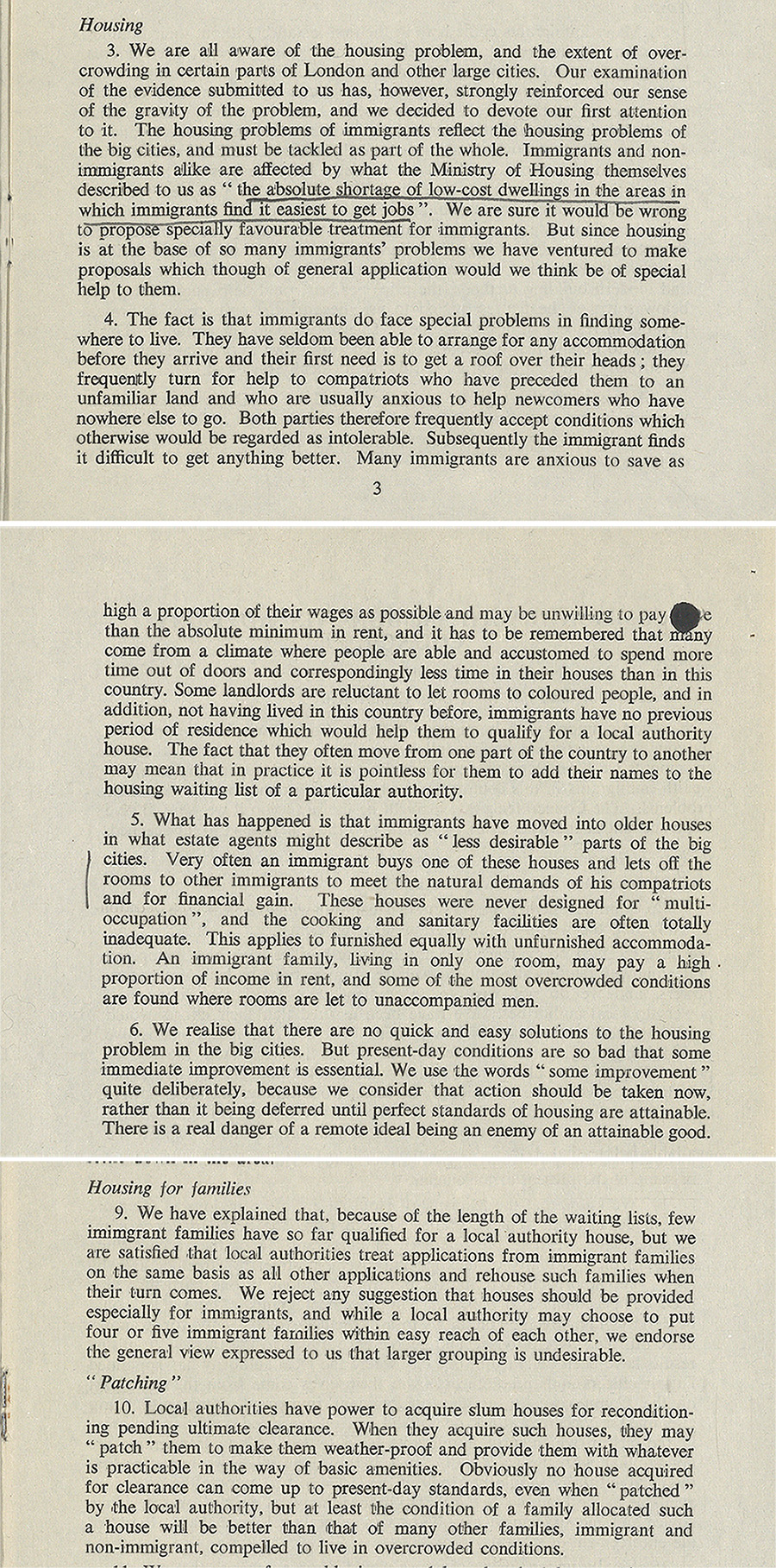
Extracts from a Report by the Commonwealth Immigrants Advisory Council, July 1963. The council was set up to advise the Home Secretary on matters affecting the welfare of Commonwealth immigrants and their integration into the community. Catalogue ref: HLG 39/32
The source gives some information on the experience of migrants in Britain in terms of finding accommodation. Not all Commonwealth immigrants were welcomed by white British communities. Despite the shortage of labour in the 1950s and 1960s, some still found it difficult to get decent jobs or accommodation.
Most of the accommodation that was available was often in the poor inner cities. Even if they did have enough money to rent better quality housing, many had to face the fact that some landlords refused to rent to Black people. In 1958 in Nottingham and London’s Notting Hill, areas where larger numbers of West Indians lived, there were outbreaks of violent attacks against them.
The language used in this source is of its time; however, it is inappropriate and unacceptable today
- What does this source reveal about housing for Commonwealth immigrants in Britain?
- What do you think the source does not reveal about the contribution made by immigrants?
- Find out about the changes in law in the 1960s concerning immigration and race relations. Why do you think these changes were made?
Transcript
…
Housing
- We are all aware of the housing problem, and the extent of overcrowding in certain parts of London and other cities. Our examination of the evidence submitted to us has, however, strongly reinforced our sense of the gravity of the problem, and we decided to devote our first attention to it. The housing problems of immigrants reflect the housing problems of the big cities and must be tackled as part of the whole. Immigrants and non-immigrants alike are affected by what the Ministry of Housing themselves described to us “the absolute shortage of low-cost dwellings in the areas in immigrants find it easiest to get jobs”. We are sure it would be wrong to propose specially favourable treatment for immigrants. But since housing is at the base of so many immigrants’ problems, we have ventured to make proposals which though of general application would we think be of special help to them.
- The fact is that immigrants do face special problems in finding somewhere to live. They have seldom been able to arrange for any accommodation before they arrive, and first need is to get a roof over their heads; they frequently turn for help to compatriots who have preceded them to an unfamiliar land and who are usually anxious to help newcomers who have nowhere else to go. Both parties therefore frequently accept conditions which otherwise would be regarded as intolerable. Subsequently the immigrant finds it difficult to get anything better. Many immigrants are anxious to save as high a proportion of their wages as possible and my be unwilling to pay more than the absolute minimum in rent, and it has to be remembered that many come from a climate where people are able and accustomed to spend more time out of doors and correspondingly less time in their houses than in this country. Some landlords are reluctant to let rooms to coloured people, and in addition, not having lived in this country before, immigrants have no previous period of residence which would help them to qualify for a local authority house. The fact that they often move from one part of the country to another may mean that in practice it is pointless for them to add their names to the housing waiting list of a particular authority.
- What has happened is that immigrants have moved into older houses in what estate agents might describe as “less desirable” parts of the big cities. Very often an immigrant buys one of these houses and lets off the rooms to other immigrants to meet the natural demands of his compatriots and for financial gain. These houses were never designed for “multi-occupation”, and the cooking and sanitary facilities are often totally inadequate. This applies to furnished equally with unfurnished accommodation. An immigrant family, living in only one room, may pay a high proportion of income in rent, and some of the most overcrowded conditions are found where rooms are let to unaccompanied men.
- We realise that there are no quick and easy solutions to the housing problem in the big cities. But present-day conditions are so bad that some immediate improvement is essential. We use the words “some improvement” quite deliberately because we consider that action should be taken now, rather than it being deferred until perfect standards of housing are attainable. There is a real danger of a remote ideal being an enemy of an attainable good.
…
- We have explained that because of the length of the waiting lists, few immigrant families have so far qualified for a local authority house, but we are satisfied that local authorities treat applications from immigrant families on the same basis as all other applications and rehouse such families when their turn comes. We reject any suggestion that houses should be provided especially for immigrants, and while a local authority may choose to put four or five immigrants within easy reach of each other, we endorse the general view expressed to us that larger grouping is undesirable.
“Patching”
- Local authorities have power to acquire slum houses for reconditioning pending ultimate clearance. When they acquire such houses, they may “patch” them to make them weather-proof and provide them with whatever is practicable in the way of basic amenities. Obviously, no house acquired for clearance can come up to present-day standards, even when “patched” by the local authority, but at least the condition of a family allocated such a house will be better than that of many other families , immigrant and non-immigrants, compelled to live in overcrowded conditions
